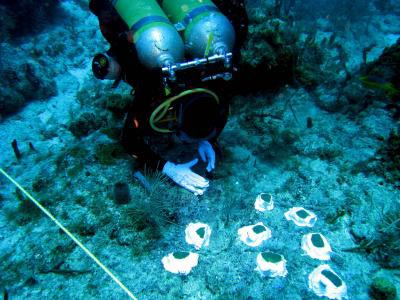8 days under the sea to improve coral restoration methods
Scientists have begun an eight-day mission, living and working 60 feet from the sea surface, to determine why some coral species survive when replanted after an event, such as a the storm, for example, while other corals die.
The world's coral reefs are suffering from the combined effects of storms, global warming, and an increase in the number of boats and sea transport. As a result, their recovery has become a priority for those who care. Working at an underwater laboratory in Key Largo, Florida at the US National Institute of Atmospheric and Oceanic Institutes NOAA, a team of scientists is working to protect coral reefs against these threats by Find a way to improve their recovery method.
'It's like living on a space station, except in the water,' said biology professor Iliana Baums. 'This work is dangerous because, once scientists dive down, their tissue will be wet with nitrogen. If they return to the water quickly, they will suffer from pneumonia, a often fatal disease because small bubbles form inside the body. Therefore, divers at the end of the job take a whole day to relieve the pressure by going back to the water very slowly. '
As a molecular ecologist, Baums offers genetic expertise to help detect whether a particular coral cluster contains genes that allow them to survive after replanting and Other difficulties, such as the rise in the temperature of the sea, or not.

Scientists are conducting experiments to determine why some corals survive when replanted after an event, such as a storm, while other corals die.(Photo: Iliana Baums, Penn State)
The team collected hundreds of coral fragments from two species - staghorn coral and a common star coral in the Caribbean. Associate Professor Baums said, 'We take this test very carefully to minimize the effect of the experiment on natural populations.'
The researchers divided each piece of coral into two parts and planted half the section into the shallow place (30 feet deep) and the other half at a depth of 60 feet to see how they reacted over time. 'By dividing the coral section, we learned that they are genetically identical, and then we can determine if the coral is able to withstand replanting due to its genetic structure or a lip factor. Some schools, ' explained Baums , an assistant professor.
While his colleagues re-planted corals into the deep, Baums and Margaret Miller at the NOAA Institute planted corals in shallow areas. Once done, the team will return to these places every month to measure their growth rate, their photosynthetic rate and the biodiversity of beneficial algae that live inside their cells. , besides other information.
Scientists hope that research results will help them improve coral restoration in the future.
- Florida Keys unknowingly found a way to recreate corals 40 times faster than the natural environment
- Nearly 1 billion VND regenerates Khanh Hoa's coral reef
- Nearly one third of Indonesia's coral reef area has been destroyed
- To protect the coral at sea, fight deforestation!
- Map the global coral
- Spawning coral: Great product of nature!
- Discover coral reefs that are as bright as a rainbow
- New hope for corals to die from global warming
- Coral sperm bank
- Vitamin C and water are not only good for humans but also for plastic.
- Explore the coral
- Successfully recreating endangered coral in the laboratory
 Surprised: Fish that live in the dark ocean still see colors
Surprised: Fish that live in the dark ocean still see colors Japan suddenly caught the creature that caused the earthquake in the legend
Japan suddenly caught the creature that caused the earthquake in the legend A series of gray whale carcasses washed ashore on California's coast
A series of gray whale carcasses washed ashore on California's coast Compare the size of shark species in the world
Compare the size of shark species in the world